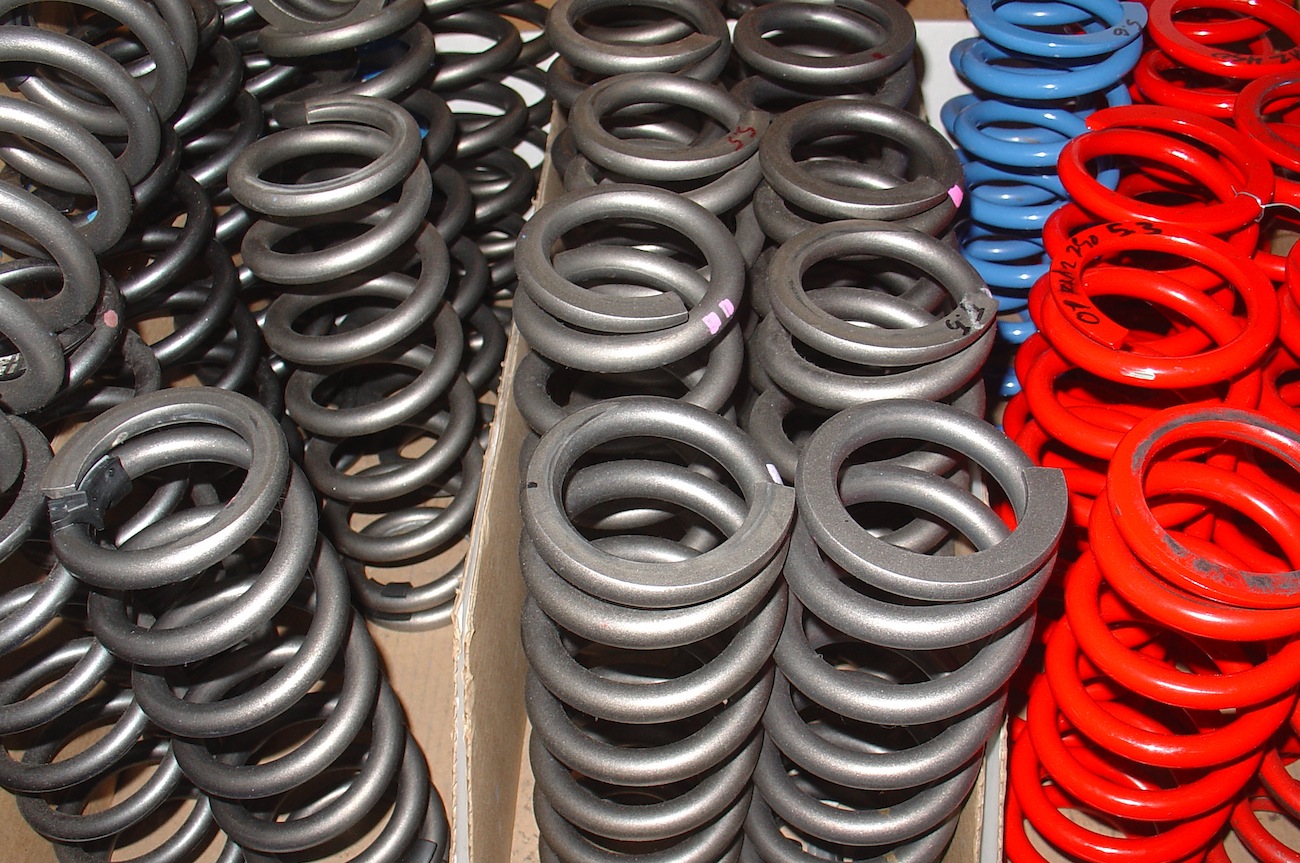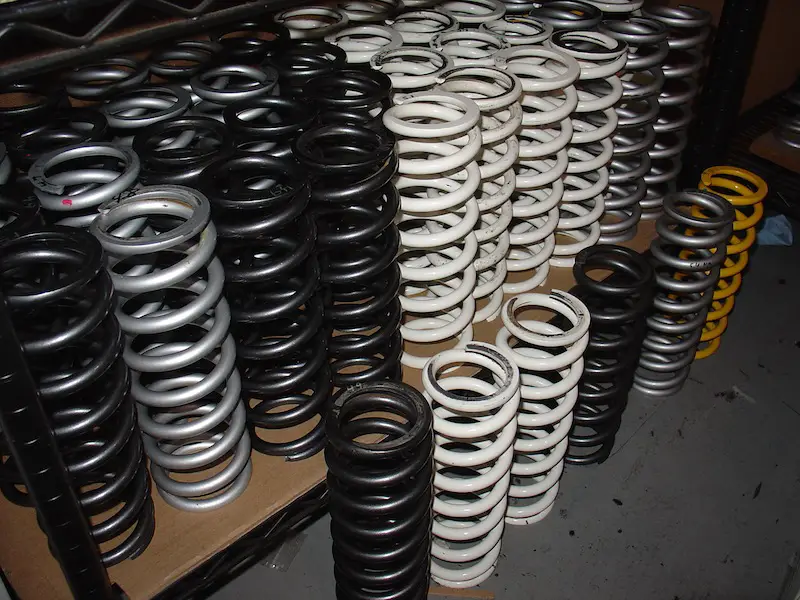TEN THINGS YOU NEED TO KNOW ABOUT SHOCK SPRINGS

(1) Most shock springs are made of silicon-chromate steel (and occasionally titanium). Material quality is a huge factor in performance. Materials with a better flex property makes a livelier, more responsive spring. Stronger material allows for fewer coils. Generally, spring manufacturers buy various diameter wires from a supplier and coil their own springs with a CNC machine. The machine feeds wire around a curved mandrel so that the coils rise up like a snake. These machines can pop out springs surprisingly fast.
(2) Imagine bending a rubber eraser into a U-shape. At the outside of the curve the material is stretched, and at the inside it is compressed. Bending wire into a spiral does this throughout the coil, creating built-in tension that hurts the performance of a shock spring. Hot-coiling springs help keep the material in a natural state, but the additional equipment and processing time relegate hot-coiled springs to products that can justify the high cost.
(3) Common bike springs are cold-coiled, but other processes are used to lessen some of that built-in tension. The spring is heat-treated to reduce the tension and cooled slowly so that it doesn’t become hard and brittle. Next, both ends of the spring are ground flat. To further reduce tension, the spring is shot-peened. Next, the spring is pressed (or pre-set) so that it does not change its free length during use. Fork springs are polished to reduce friction inside the fork legs (rear shock springs are not polished). A steel rear spring needs a coating to prevent corrosion. Epoxy-based powder coating can survive the flexing. Titanium isn’t prone to rusting and can be left raw. The fork springs are simply given a coat of oil to protect them until installation.
(4) The shape and physical dimensions of a spring play a big role in performance. Springs are not usually perfect cylinders; they are barrel-shaped. Otherwise, during compression, they could bow into the shock body, which would hurt performance. A shorter wire means that when force is applied to one side of the spring, it takes less time to transfer to the other side, and this translates to liveliness and responsiveness. Wire diameter is a critical predictor of spring stiffness, with a larger diameter being stiffer. Conversely, the larger the overall diameter of the coils themselves (the distance between the coils), the softer it will be.

(5) Hooke’s law says that when a spring is compressed, the force it exerts is proportional to its change in length. A spring rate (or spring constant) is the change in the force it exerts divided by the change in distance (deflection). So spring-testing machines, simply clamp down and take those measurements. The rate is expressed in kilograms per millimeter (kg/mm) or Newton meters (Nm). The numbers are very similar, so it’s important to pay attention to the unit. Luckily, the conversion is very simple: just add or subtract one-tenth and move the decimal one spot to change Newtons to kilograms or vice versa. A 5.1 kg/mm spring is a 50 Nm.
(6) A progressive-rate spring is one in which the spring rate changes throughout the compression of the spring. There are many ways to achieve it, such as varying the overall diameter, the angle of the coils or the size of the wire diameter over the length of the spring. The rate of a progressive spring is expressed in two numbers, delineating the rates at the beginning and end of the spring’s compression. This gives an idea of stiffness, but doesn’t predict where in the stroke the change will take place. Therefore, progressive springs can be an effective tool, because they introduce a big variable that requires very careful tuning to get right.
(7) Springs aren’t perfect, so they are all slightly progressive to some extent. Unfortunately, most of that change takes place in the first part of the deflection where sag is measured. The result can be confusion and frustration for suspension tuners, because different brands of springs that claim to have the same spring rate can give different sag numbers. The moral of the story is to stick to the same spring brand when tuning your suspension.
(8) As a coil shock is compressed, some of the force is turned into rotational force that wants to twist the spring. This causes binding that can hurt performance. Since fork springs are longer, with more coils, they want to twist a lot more than shock springs. Most modern OEM forks have a built-in thrust washer to prevent binding, but OEM shocks don’t. There are aftermarket needle bearing units available from Pivot Works and Factory Connection that lessen binding.
(9) The weight of a spring is important, because half of its weight is unsprung, further affecting suspension performance. A titanium spring does not have the same dimensions as a steel spring for the same application. Since Ti is lighter and stronger, fewer coils and less material can be used. The result is a significant weight savings and performance gain. However, the printed spring rate on a Ti spring is not always accurate. It’s best to have a Ti shock spring tested for its actual rate before using it and finding out that what they said was a 45 N/mm was really a 42 N/mm.
(10) Theoretically, suspension springs don’t wear out or lose their springiness, because they never truly reach their elastic limit. But for many reasons, it’s a good idea to check race sag constantly and if you notice major changes, the spring has been over-stressed and should be replaced.






Comments are closed.